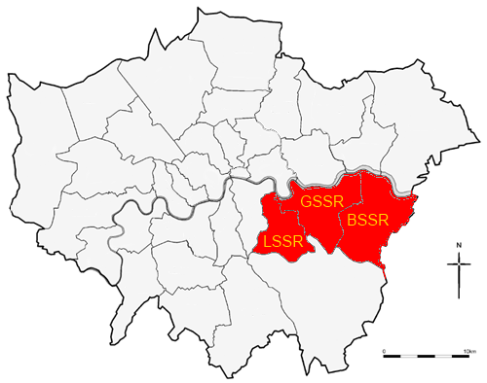The Union of South London Soviet Socialist Republics was officially reformed today at 9pm UK time. It came after months of discussion between former leading political figures of the country, which was dissolved in September of 2011. Only the former Republic of Leestan remained apart from the United Kingdom following the period of collapse, in the guise of the Lewisham Democratic Republic.
Earlier this year, 2013, members of the Socialist Unity Party of Lewisham declared their intention to reform the Union and have gone about adjusting the internal divisions of the Union into only three Republics, those being Lewisham, Greenwich and Bexley. This more streamlined system of Republics is expected to do away with the problems of the previous system which was not clearly defined by the state.
This act however did see the end of the Lewisham Democratic Republic. President Whitmarsh signed off the final piece of legislation from the Volkskammer which stated, in brief, that 1. The USLSSR is deemed to be the successor state to Lewisham DR 2. All State functions of the LDR are to cease and be turned over to Soviet authorities. After this legislation was approved, the Socialist Unity Party dissolved itself after publically accepting that it was not the organisation that could play the legitimate role as the vanguard Party of the people of South London.
Shortly after the dissolution of the SUPL, the party’s former members agreed to form the Communist Party of the Union of South London Soviet Socialist Republics and claim direct lineage from the party which formerly held this name. Immediately following the formation of the party a congress was called within which the independence of the USLSSR was declared.
In a statement given by the USLSSR’s new President, Alex Whitmarsh, ‘friendship and cooperation between ourselves and our Socialist brothers around the globe’ is the immediate goal in the international arena for the USLSSR, alongside affirming their membership of the GUM and AMU.
Below is the basic outline of the organs of the state, as provided by the Soviet Government itself.
Part One: The Soviet Socialist Republics of the Union
The former system of Republics was unclear and confusing. From now there shall be three Republics within the Union along with a Republic in Antarctica which is to be directly governed by Presidential decree.
Republics of the Union
Lewisham SSR
Greenwich SSR
Bexley SSR
Territories
Antarctic SSR
Part 2: Government
The structure of the Government is largely unchanged for the original incarnation of the USLSSR, with the President at its head, advised by the Commissars, working in tandem with the legislative power of the Supreme Soviet.
1. Executive Branch
1a. President of the Union – Head of Government and State. Elections for this office take place on an annual basis.
1b.Vice-President – Head of Government and State in the absence of the President. Elections for this office take place on an annual basis.
1c. Chairman – Head of the CPUSLSSR’s Politburo
1d. Politburo – A Communist Party organ comprised of the President, General Secretary of the CPUSLSSR and the Commissars for the Interior Affairs. Makes the day to day decisions of state and approves legislation from the Supreme Soviet.
1e. Commissariats (Commissars appointed by President)
- People’s Commissariat of Foreign Affairs
- People’s Commissariat of Interior Affairs
- People’s Commissariat of Public Services
- People’s Commissariat of Agriculture and Industry
- People’s Commissariat of Justice
- People’s Commissariat of Culture and Sport
- People’s Commissariat of Gay/Bi/Lesbian Affairs
2. Legislative Branch
2a. The Supreme Soviet – the highest legislative body of the Union, passes laws that apply to all Republics. Members are elected from regional Soviets and all legislation requires Politburo approval.
2b. Regional Soviets – Act as each Republic’s national legislature, passing regionalised laws that affect individual republics alone. All legislation can be overruled by the Supreme Soviet or the Politburo. Legislation also requires the approval of the President of the Union.
2c. Local Soviets – Local Soviets are the point of entry of all People’s Representatives, legislation created here is to deal with localised issues and not national issues. All legislation can be overturned by the Supreme Soviet, a Regional Soviet or by the President or Politburo. Legislation requires the approval of local Communist Party Official.
3. Judicial Branch
3a. Supreme Court – The Politburo selects the sitting panel of Judges for trials and other legal cases as and when they are required. The Supreme Court is used for cases of the highest importance to the state and is also the highest court of appeal for criminal convictions.
3b. Worker’s Court – Acts as the court for the settlement of minor cases. Presided over by a locally elected council and informed by the People’s Commissariat of Justice. A local official of the CPUSLSSR is to be in attendance of each session. The maximum penalty that can be given by these courts is that of a 30 Ruble fine and/or banning from sitting on a Local Soviet for a period of no longer than 90 days.

Good to see the USLSSR back.
you don’t even remember the USLSSR